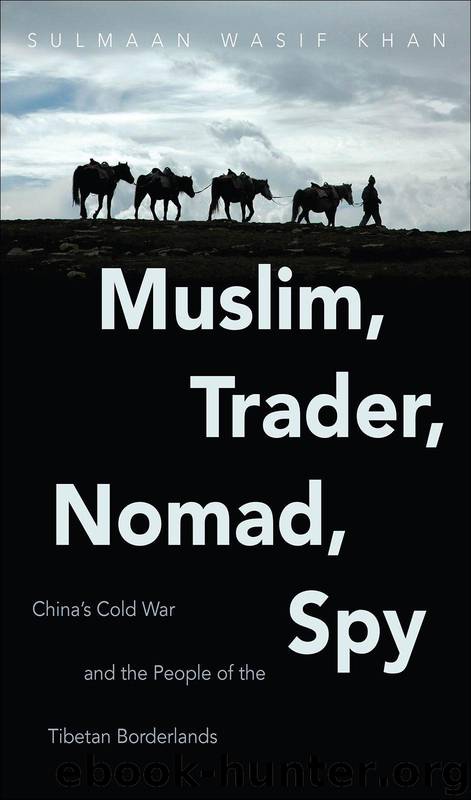Muslim, Trader, Nomad, Spy: China's Cold War and the People of the Tibetan Borderlands (The New Cold War History) by Sulmaan Wasif Khan

Author:Sulmaan Wasif Khan
Language: eng
Format: mobi, azw3, epub
Publisher: The University of North Carolina Press
Published: 2015-03-22T22:00:00+00:00
Old Rights, New Worries
On November 27, 1961, fourteen nomadic herdsmen of Ladakhi origin entered the grasslands of Seerya. They brought with them some eight hundred cows and goats to pasture. The prefectural authorities of Ali informed them that they needed to sign in and pay a tax for grazing; the chief herdsman countered that they had customary grazing rights in Indian territory. This shocked Ali officials. The herdsmen, they explained, were on what was unquestionably Chinese land. Once this had been explained the nomads backed off, but the problem confronting the PRC on its Tibetan frontier had been defined.28 Traditional patterns of movement had become tangled inextricably with the Sino-Indian border conflict. Once upon a time nomads crossing the border had just been people in search of pasture for their animals. Now they could be agents of Indian territorial expansionism, staking claim to disputed territory.
What made the problem so hard was the almost complete ignorance officials had concerning the fourth world. No one knew just how many nomads there were, only that they had been there for as long as anyone could remember. They came and went with the grass, and since grass pays no heed to the squabbles between states, most of the nomads saw little reason to do so either. Local officials were not blind to the complications. There were, they reported, customary nomads and non-customary nomads, nomads in search of pasture and nomads who had come from India only to do harm to the PRC, nomads who fell within the boundaries China claimed but outside the area it actually controlled. There were nomads who were Chinese by citizenship but who went to India and returned following their customary routes—and no one knew what sort of ideas and political attitudes they might have picked up on their sojourns abroad. One of the reasons they had left in the first place was their failure to understand PRC policy; it was fitting, therefore, to improve their understanding by being gentle with them. But you could not guarantee that they were safe to let in.29
It was the classic dilemma of counterinsurgency: to detect and crush real troublemakers without alienating ordinary citizens. How could you tell the traditional nomad from the hired spy, the follower of grass from a government agent subtly claiming more land? You did not want to disrupt traditional patterns of movement unnecessarily; to do so would exacerbate economic difficulty and social unrest. But those patterns posed a threat, for mixed in with nomads moving from pasture to pasture were more malevolent characters, who “clearly . . . are in the service of the Indian reactionaries to conduct an armed provocation and invade our sovereign territory.”30 You wanted to foil Indian conspiracies while winning over the Indian nomads (who might, properly placated, be useful) and preventing an international incident. You wanted your own people to feel welcome in what you told them was their homeland—and yet you were wary of letting them into the enemy’s country.
It was a murky, complicated problem—and the measures you adopted reflected that murkiness.
Download
Muslim, Trader, Nomad, Spy: China's Cold War and the People of the Tibetan Borderlands (The New Cold War History) by Sulmaan Wasif Khan.azw3
Muslim, Trader, Nomad, Spy: China's Cold War and the People of the Tibetan Borderlands (The New Cold War History) by Sulmaan Wasif Khan.epub
This site does not store any files on its server. We only index and link to content provided by other sites. Please contact the content providers to delete copyright contents if any and email us, we'll remove relevant links or contents immediately.
| Africa | Americas |
| Arctic & Antarctica | Asia |
| Australia & Oceania | Europe |
| Middle East | Russia |
| United States | World |
| Ancient Civilizations | Military |
| Historical Study & Educational Resources |
The Sympathizer by Viet Thanh Nguyen(4282)
The Rape of Nanking by Iris Chang(4119)
World without end by Ken Follett(3409)
Ants Among Elephants by Sujatha Gidla(3388)
Blood and Sand by Alex Von Tunzelmann(3113)
Japanese Design by Patricia J. Graham(3089)
City of Djinns: a year in Delhi by William Dalrymple(2493)
The Queen of Nothing by Holly Black(2458)
Foreign Devils on the Silk Road: The Search for the Lost Treasures of Central Asia by Peter Hopkirk(2418)
India's Ancient Past by R.S. Sharma(2391)
Inglorious Empire by Shashi Tharoor(2383)
Tokyo by Rob Goss(2365)
In Order to Live: A North Korean Girl's Journey to Freedom by Yeonmi Park(2325)
Tokyo Geek's Guide: Manga, Anime, Gaming, Cosplay, Toys, Idols & More - The Ultimate Guide to Japan's Otaku Culture by Simone Gianni(2301)
India's biggest cover-up by Dhar Anuj(2297)
The Great Game: On Secret Service in High Asia by Peter Hopkirk(2284)
Goodbye Madame Butterfly(2187)
Batik by Rudolf Smend(2091)
Living Silence in Burma by Christina Fink(2023)
